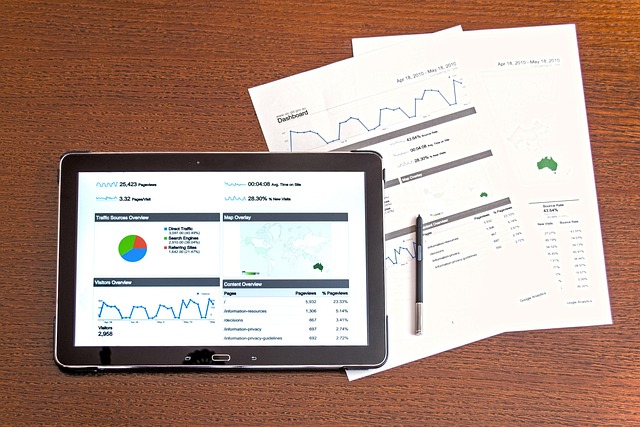In today's digital era, marketing analytics for digital marketing have advanced significantly, integrating data from diverse channels like email, social media, and CRM platforms. Dashboards streamline this data, allowing marketers to identify trends, optimize campaigns, and make data-driven decisions via intuitive charts and graphs. Interactive features such as drag-and-drop functionality and AI chatbots enhance efficiency, while seamless integration with existing systems ensures real-time data access. Prioritize platforms with robust API integrations and easy-to-understand visualizations for effective marketing analytics and enhanced digital marketing success.
In today’s data-driven landscape, understanding digital marketing performance is crucial for informed decision-making. This article explores how effective marketing dashboards transform complex marketing analytics into actionable insights. We delve into identifying key digital marketing metrics, the power of visual storytelling, and interactive features that elevate user experience. Additionally, we guide you through selecting the right tools for seamless data integration, ensuring your marketing analytics are accessible, intuitive, and tailored to your needs.
- Understanding Digital Marketing Data Needs
- Key Metrics for Effective Marketing Dashboards
- Visualizing Data for Instant Comprehension
- Interactive Features Enhancing User Experience
- Choosing Tools for Seamless Integration
Understanding Digital Marketing Data Needs

In today’s digital marketing landscape, understanding data needs is crucial for success. Marketing analytics for digital marketing have evolved beyond basic metrics to include complex interactions across various channels such as email marketing, social media marketing automation, and customer relationship management (CRM) platforms. Each of these tools provides unique insights into consumer behavior, engagement rates, and campaign effectiveness. For instance, email marketing campaigns can offer data on open rates, click-throughs, and conversions, while CRM systems track customer interactions, sales pipelines, and retention rates. Integrating this diverse data is essential to gain a holistic view of marketing performance.
Marketing dashboards must be designed with these varied data needs in mind. Effective marketing analytics tools streamline the collection, organization, and visualization of data from these disparate sources into user-friendly interfaces. By presenting data in clear, intuitive formats, such as charts, graphs, and tables, marketers can quickly identify trends, patterns, and outliers without getting overwhelmed by the volume or complexity of the information. This enables them to make informed decisions, optimize campaigns, and ultimately enhance overall marketing effectiveness.
Key Metrics for Effective Marketing Dashboards

Marketing dashboards are a powerful tool for digital marketers to track key metrics and gain valuable insights from marketing analytics. An effective dashboard should include a concise yet comprehensive view of critical performance indicators, enabling marketers to make data-driven decisions. Key metrics such as website traffic, conversion rates, customer acquisition cost (CAC), return on investment (ROI), and customer lifetime value (LTV) are essential for understanding the overall health of marketing campaigns. By monitoring these metrics in real-time, marketers can quickly identify trends, areas of improvement, and opportunities for optimization.
Additionally, integrating features like automation and reputation management into marketing dashboards further enhances their utility. Automation allows for streamlined data collection and reporting, ensuring that marketers have up-to-date information without manual intervention. Meanwhile, reputation management tools help track brand mentions, sentiment analysis, and customer feedback, providing valuable context to the data displayed on the dashboard. This holistic approach ensures that marketing analytics are not just numbers but actionable insights driving successful digital marketing strategies.
Visualizing Data for Instant Comprehension

In today’s digital era, effective marketing requires instant comprehension of complex data for informed decision-making. Marketing dashboards play a pivotal role here by transforming raw numbers into visually appealing and easily digestible formats. Charts, graphs, and infographics are powerful tools that allow marketers to quickly identify trends, outliers, and areas requiring attention. For instance, visualizing sales performance over time can reveal seasonal patterns or growth trajectories, enabling strategic planning for digital marketing campaigns.
Moreover, these visual representations facilitate the tracking of key performance indicators (KPIs) specific to various marketing channels like email marketing and marketing automation. In the case of a missed call text-back campaign, a dashboard could instantly show conversion rates, response times, and customer engagement metrics. This real-time data visualization not only helps in course correction during ongoing campaigns but also aids in evaluating the success and ROI of different strategies, be it content marketing or social media advertising.
Interactive Features Enhancing User Experience

Interactive features play a pivotal role in enhancing the user experience of marketing dashboards, making complex data more accessible and digestible for digital marketers. Tools such as drag-and-drop functionality, real-time updates, and interactive visualizations like graphs and charts allow users to explore insights intuitively. For instance, a dynamic heatmap can help visualize website traffic patterns, while customizable filters enable precise analysis of specific campaigns or demographics. These interactive elements ensure that marketers can quickly uncover trends, identify areas for improvement, and make data-driven decisions with confidence.
Moreover, integrating AI chatbots and missed call text-back systems into these dashboards can further elevate the user experience. AI chatbots provide instant support, offering explanations or suggesting insights based on user queries, while missed call text-back features enable quick data retrieval and notifications, ensuring marketers stay updated without constant manual checks. These innovations streamline workflows, enhance productivity, and contribute to a more efficient customer relationship management (CRM) process by making marketing analytics as intuitive as possible for digital marketing professionals.
Choosing Tools for Seamless Integration

When selecting tools for your marketing dashboard, seamless integration should be a top priority. Look for platforms that effortlessly sync with your existing digital marketing analytics systems and data sources, such as Google Analytics, social media insights, and CRM software. This ensures a comprehensive view of campaign performance by providing real-time data without any gaps or duplication in effort.
Choosing tools that offer robust API integrations and APIs themselves makes it easy to automate data retrieval and analysis processes. This not only saves time but also minimizes the risk of missed call text back (or similar customer interactions) due to delayed or manual updates. Moreover, consider features for efficient reporting and visualization, such as interactive graphs and charts, to make complex marketing analytics accessible and actionable for everyone in your team—even those without extensive technical backgrounds, enhancing overall reputation management.
Marketing dashboards that simplify data interpretation are a game-changer for digital marketers. By understanding key metrics, visualizing data, incorporating interactive features, and integrating seamless tools, businesses can navigate their marketing analytics with ease. This approach empowers folks to make informed decisions, fostering effective strategies and enhancing overall performance in today’s competitive landscape.
